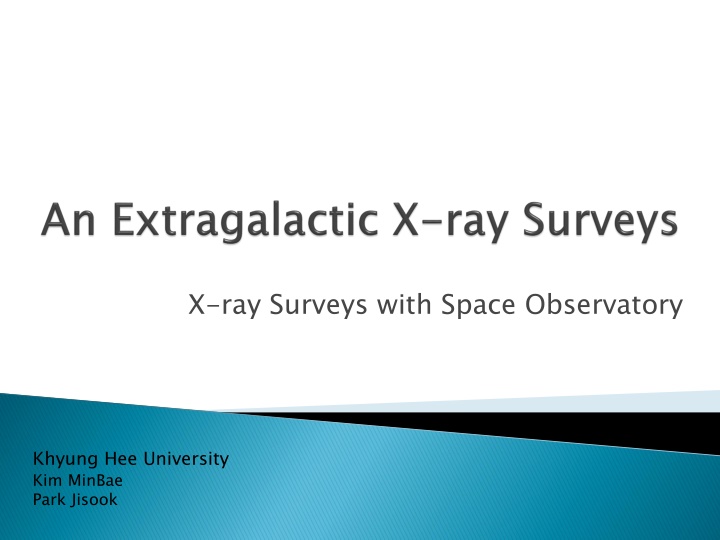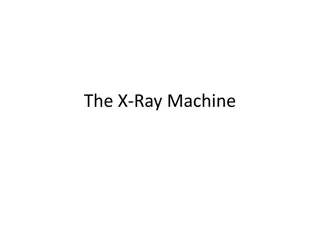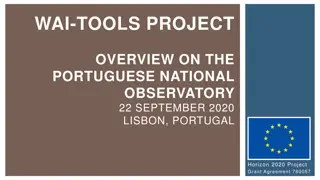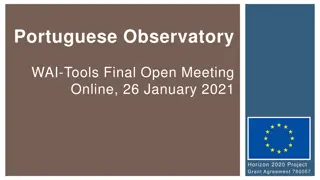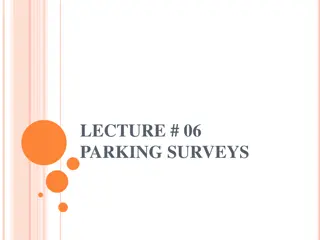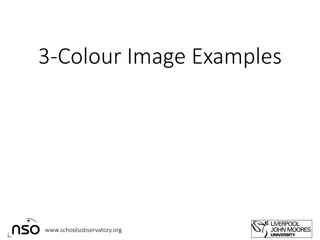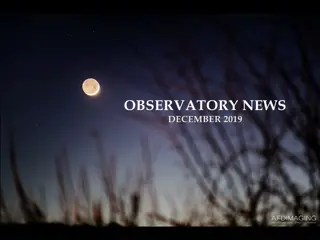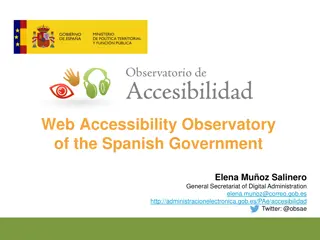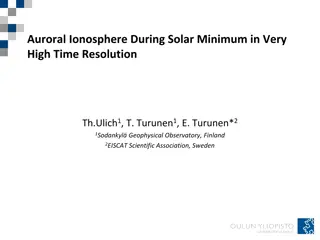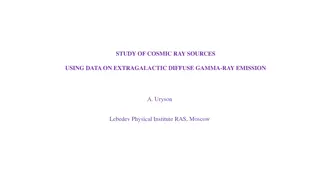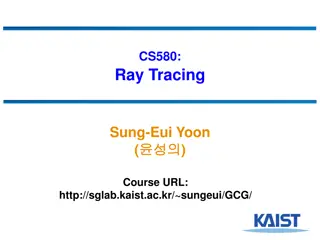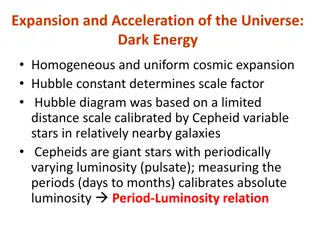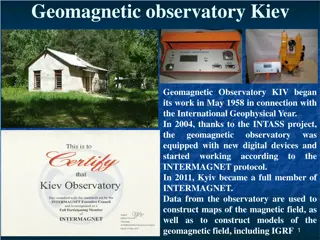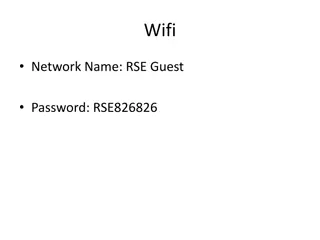Exploring the Universe: X-Ray Surveys with Space Observatory
Delve into the fascinating world of X-ray surveys conducted by the Space Observatory at Khyung Hee University. Learn about the significance of X-ray surveys in detecting emission from hot regions of the Universe, minimizing errors in redshift measurements, extending the sample to higher redshifts, and uncovering obscured Active Galactic Nuclei (AGNs). Discover the powerful NASA Chandra X-Ray Observatory and ESA X-Ray Multi-Mirror (XMM) Newton missions, as well as detailed surveys like the Chandra Deep Field South and the All-wavelength Extended Groth Strip International Survey. Explore how multi-wavelength follow-up of X-ray sources is crucial in understanding the properties of celestial objects.
Download Presentation

Please find below an Image/Link to download the presentation.
The content on the website is provided AS IS for your information and personal use only. It may not be sold, licensed, or shared on other websites without obtaining consent from the author.If you encounter any issues during the download, it is possible that the publisher has removed the file from their server.
You are allowed to download the files provided on this website for personal or commercial use, subject to the condition that they are used lawfully. All files are the property of their respective owners.
The content on the website is provided AS IS for your information and personal use only. It may not be sold, licensed, or shared on other websites without obtaining consent from the author.
E N D
Presentation Transcript
X-ray Surveys with Space Observatory Khyung Hee University Kim MinBae Park Jisook
Why X-ray Survey? Chandra & XMM-Newton Survey with Chandra X-ray Observatory Survey with XMM-Newton eROSITA ASTRO-H
To detect X-ray emission from very hot regions of the Universe. The minimizing quasar and galaxy photometric redshift errors and extending the sample to higher redshift. The X-ray Surveys make to find obscured AGNs and other AGNs with weak optical signatures. Multi-wavelength follow-up of detected X-ray sources is crucial to understand the properties of the observed objects.
Two powerful and active X-ray missions. NASA : Chandra X-Ray Observatory ESA : X-Ray Multi-Mirror (XMM) Newton
Chandra Deep Field South 1Ms Survey (Giacconi et al. 2002) 2Ms Survey (Luo et al. 2008) 4Ms Survey (Xue et al. 2012) Main Chandra Source Catalog RA 3h32m28.0s Dec -27deg48 30.0 (J2000) 464.5 arcmin , 3.872Ms 740 sources (75% AGN) 300 new sources (2Ms->4Ms) (65%: AGN,35%: normal & starburst galaxies,1% stars) 0 < z < 8 97% have multi-wavelength counterparts (optical/near- IR/IR/radio)
All-wavelength Extended Groth strip International Survey X-ray catalogue for AIGES (Laird et al. 2009) The Extended Groth Strip (EGS: RA=14h 17m, Dec= +52deg 30 , small region in the constellation Ursa Major), 0.67deg , 1.8Ms 1325 sources Optical(76%), IR(94%, DEEP2,CFHTLS, Spitzer/IRAC surveys of the EGS)
The Celestial Equator in the Southern Galactic Cap ( Stripe 82 ) ( 20h24 < RA < 04h08 , -1.27deg < Dec< 1.27deg, total 300deg ) 2073, 607, 2079 (soft, hard, full) 16.5 deg for Stripe 82-X Chandra 7.4deg (LaMassa et al. 2013a) XMM 10.5deg (LaMassa et al. 2013b) (overlaps 1.5 deg ) - - 3362 sources high luminosity source (L_x 10^45 erg/s) : 657 sources, 125 AGN sources are z > 2, (Urry et al. 2013) UV(GALEX), Near-IR(UKIDSS, WISE), ugriz-band(SDSS), radio(FIRST)
XMM-COSMOS RA 23h29m18.4s Dec -54deg40 33.6 (center), 2deg 322 sources of AGN, 60% of total Redshift of AGN : 0.4 < z < 4.25 UV(GALEX), U-band(CFHT), BVRiz(Subaru), K-band(CTIO/Kitt peak), radio(VLA), mid-IR(Spitzer), i-band(HST) C-COSMOS (Elvis et al. 2009) 1760 source in 0.8 deg , 200ks COSMOS-Legacy (for 2 deg )
The ultimate XMM-Newton extragalactic survey 2011~ 2013 Two extragalactic regions of each 25 deg 1. CFHTLS W1 region : RA 2h23m, Dec -4deg30 (J2000) , 25 deg 2. BCS region : RA 23h30m, Dec-55deg00 (J2000) , 25 deg each,10~>40ks - - - Galaxy cluster : 600~1400(out to z~1.5-2) AGN : 18000 (out to z~4) Multi-wavelength(northern field/southern field) : Optical, UV, NIR, mid-, far-IR, radio
XMM-Newton Blanco Cosmology survey project RA 23h29m18.4s, Dec - 54deg40 33.6 (center), 14 deg Initial 6 deg (Suhada et al. 2012) - Point sources > 2000 - Clusters: 45 Optical, near-IR (SZE)
eROSITA will be launched In 2015. (German+Russian) eRASS (eROSITA All-sky survey) The expection of 3 million AGNs in soft band - To detect the hot intergalactic medium of 50~100 thousand galaxy clusters and groups and hot gas in filaments between clusters to map out the large scale structure in the universe for the study of cosmic structure evolution - To study in detail the physics of galactic X-ray source populations, like pre-main sequence stars, supernova remnants and X-ray binaries.
(M.J.Freyberg, R.Egger (1999), "ROSAT PSPC All-Sky Survey maps completed)
eROSITA planned survey area versus flux in comparison to existing surveys
ASTRO-H will be launched In 2015. (JAXA+ US) - To explore the structure and evolution of Universe - The most sensitive wideband observation over an energy range from 0.3 to 600 keV Instruments - Hard X-ray: Telescope, Imager - Soft X-ray: Telescope, Imager, Spectrometer - Gamma-ray: detector
